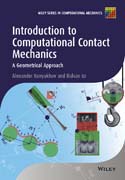
Introduction to Computational Contact Mechanics: A Geometrical Approach
Konyukhov, Alexander
Izi, Ridvan
Introduction to Computational Contact Mechanics: A GeometricalApproach covers the fundamentals of computational contactmechanics and focuses on its practical implementation. Part one ofthis textbook focuses on the underlying theory and covers essentialinformation about differential geometry and mathematical methodswhich are necessary to build the computational algorithmindependently from other courses in mechanics. The geometricallyexact theory for the computational contact mechanics is describedin step–by–step manner, using examples of strict derivation from amathematical point of view. The final goal of the theory is toconstruct in the independent approximation form /so–calledcovariant form, including application to high–order andisogeometric finite elements. The second part of a book is a practical guide for programming ofcontact elements and is written in such a way that makes it easyfor a programmer to implement using any programming language. Allprogramming examples are accompanied by a set of verificationexamples allowing the user to learn the research verificationtechnique, essential for the computational contact analysis. Key features: Covers the fundamentals of computational contact mechanics Covers practical programming, verification and analysis ofcontact problems Presents the geometrically exact theory for computationalcontact mechanics Describes algorithms used in well–known finite element softwarepackages Describes modeling of forces as an inverse contactalgorithm Includes practical exercises Contains unique verification examples such as the generalizedEuler formula for a rope on a surface, and the impact problem andverification of thå percussion center Accompanied by a website hosting software Introduction to Computational Contact Mechanics: A GeometricalApproach is an ideal textbook for graduates and seniorundergraduates, and is also a useful reference for researchers andpractitioners working in computational mechanics. INDICE: Preface viiiAcknowledgements xiPart One Theory 11 Introduction with a spring–mass frictionless contact system 21.1 Structural part – deflection of spring–mass system 31.2 Contact part non–penetration into rigid plane 31.3 Contact formulations 42 General formulation of a contact problem 112.1 Structural part formulation of a problem in linear elasticity 112.2 Formulation of the contact part (Signorini s problem) 143 Differential geometry 193.1 Curve and its properties 193.2 Frenet formulas in 2D 233.3 Description of surfaces by Gauss coordinates 243.4 Differential properties of surfaces 324 Geometry and kinematics for arbitrary two body contact problem 404.1 Local coordinate system 414.2 Closest Point Projection (CPP) procedure Analysis 434.3 Contact kinematics. 505 Abstract form of formulations in computational mechanics 545.1 Operator necessary for the abstract formulation 545.2 Abstract form of iterative method 555.3 Fixed point theorem (Banach) 565.4 Newton iterative solution method 585.5 Abstract form for contact formulations 616 Weak formulation and consistent linearization 656.1 Weak formulation in the local coordinate system 666.2 Regularization with penalty method 676.3 Consistent linearization 676.4 Application to the Lagrange multipliers and to the following forces 716.5 Linearization of the convective variation 736.6 Nitsche method 737 Finite element discretization 767.1 Computation of the contact integral for various contact approaches 767.2 Node–To–Node (NTN) contact element 787.3 Nitsche Node–To–Node (NTN) contact element 807.4 Node–To–Segment (NTS) contact element 817.5 Segment–To–Analytical–Surface (STAS) approach 887.6 Segment–To–Segment (STS) Mortar approach 948 Verification with analytical solution 998.1 Hertz problem 998.2 Rigid flat punch problem 1048.3 Impact on moving pendulum center of percussion 1068.4 Generalized Euler–Eytelwein problem 1089 Frictional contact problems 1119.1 Measures of contact interactions sticking and sliding case. Friction law. 1119.2 Regularization of tangential force and return mapping algorithm 1129.3 Weak form and its consistent linearization 1189.4 Frictional Node–To–Node (NTN) contact element 1199.5 Frictional Node–To–Segment (NTS) contact element 1239.6 NTS frictional contact element 125Part Two Programming and Verification Tasks 12710 Introduction into programming and verification tasks 12811 Lesson 1 Nonlinear structural truss elmt1.f 13211.1 Implementation 13411.2 Examples 13812 Lesson 2 Nonlinear structural plane elmt2.f 14412.1 Implementation 14512.2 Examples 15013 Lesson 3 Penalty Node–To–Node (NTN) elmt100.f 15413.1 Implementation 15613.2 Examples 15814 Lesson 4 Lagrange multiplier Node–To–Node (NTN) elmt101.f 16114.1 Implementation 16314.2 Examples 16515 Lesson 5 Nitsche Node–To–Node (NTN) elmt102.f 16715.1 Implementation 16915.2 Examples 17116 Lesson 6 Node–To–Segment (NTS) elmt103.f 17316.1 Implementation 17516.2 Examples 17816.3 Inverted contact algorithm following force 18217 Lesson 7 Segment–To–Analytical–Segment (STAS) elmt104.f 18617.1 Implementation 18817.2 Examples 19117.3 Inverted contact algorithm general case of following forces 19418 Lesson 8 Mortar / Segment–To–Segment (STS) elmt105.f 20218.1 Implementation 20418.2 Examples 20718.3 Inverted contact algorithm following force 20919 Lesson 9 Higher order Mortar / STS elmt106.f 21319.1 Implementation 21519.2 Examples 21920 Lesson 10 3D Node–To–Segment (NTS) elmt107.f 22320.1 Implementation 22520.2 Examples 22921 Lesson 11 Frictional Node–To–Node (NTN) elmt108.f 23321.1 Implementation 23521.2 Examples 23722 Lesson 12 Frictional Node–To–Segment (NTS) elmt109.f 23922.1 Implementation 24122.2 Examples 24523 Lesson 13 Frictional higher order NTS elmt110.f 25023.1 Implementation 25123.2 Examples 25624 Lesson 14 Transient contact problems 25924.1 Implementation 26024.2 Examples 262A Numerical integration 264A.1 Gauss quadrature 266B Higher order shape functions of different classes 268B.1 General 268B.2 Lobatto class 268B.3 Bezier class 271
- ISBN: 978-1-118-77065-8
- Editorial: Wiley–Blackwell
- Encuadernacion: Rústica
- Páginas: 304
- Fecha Publicación: 05/06/2015
- Nº Volúmenes: 1
- Idioma: Inglés
